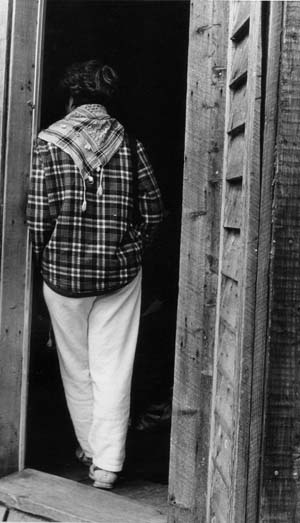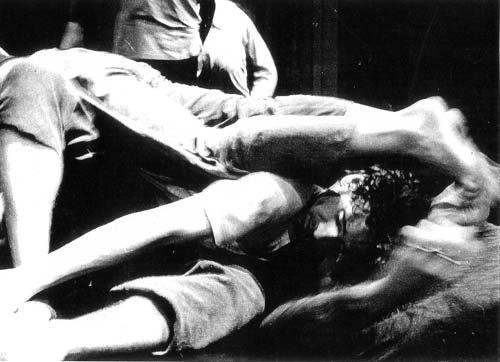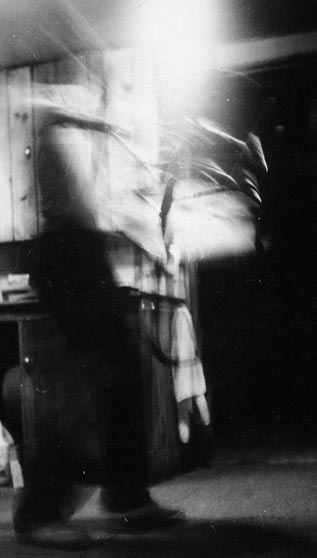
The Movement of Attention
An interview with Daniel Lepkoff
by: Simone Forti
December 2005
Published in: The Movement Research Performance Journal Spring 2005 #29

Simone Forti
Photo by: Daniel Lepkoff, 2000
Simone:
Can you say in what realm your questions or your thoughts are? Are they aesthetic or related to community, not that you'd have to separate those?
Daniel:
From my observations of people around me in dance classes and performances, especially here in NY, I sense that a certain fundamental understanding or approach to dancing that used to be common knowledge and that once surrounded me is absent.
Simone:
If I understand you are saying there is a set of understandings or a field that used to be shared and that you operate by and that they can be forgotten if they are not reiterated.
Daniel:
Yes, for example in this improvisation festival that just happened. I feel many of the younger dancers who are exploring improvisation or spontaneous composition are unaware of a wealth of inspired research and developed knowledge that I think might be very apropos to their questions.
I recently attended two performance showcase events at the "Improvisation is Hard" festival. I went to see my friends Vicky Shick and Diane Madden perform but I saw many different performers on each night. After the second show I realized that the atmosphere in both of these concerts offered no empty space. Both evenings I attended were facilitated by MC's. The MC's did more than facilitate the flow of events, they were themselves full blown theatrical standup comedic acts that kicked in between every piece, a rhythm similar to television. There were no gaps.
In many of the pieces I saw I felt the artists placed an emphasis on manifesting a striking and unusual image performed with total confidence and conviction. This idea that the performer is the creator or manufacturer of the image itself is a different paradigm than the performer as a vehicle for the audience's images; that performing is a communication and when something magic happens in the theater it is created by a confluence or symbiosis of both the audience and performer together.
Simone:
I think of years ago, what we were doing was exploring various interests, and performance was the medium in which we would explore them, so it wasn't so much of a presentational thing as a sharing of thoughts and interests...and...it wasn't that performance was something you could do...there was no pattern there that you could do one of...it was more a question of "lets look at this"...and it could be very kinetic...by ideas and thoughts I don't mean just verbally thinking.
Anyway, you said earlier there were certain understandings that you do not see now. Could you shed some light on these understandings? Let's continue in this direction.
Daniel:
My reaction to these recent performances shows me again that emptiness is very basic to my creative process, to my approach toward researching movement...an approach that involves observation, quieting oneself and having the presence of something come to you.
Watching Diane (Madden) was interesting for me. Years ago, Diane and I worked a lot together in a group called Channel Z and we also made two duet collaborations*. Ultimately Diane devoted herself to the work of Trisha Brown and even at the time we were working together she was deeply involved with Trisha's work. So Diane's dance career has been very different from mine, yet watching Diane dance I saw a physical practice that is very familiar to me. She walked into the performing space and began by taking time to tune herself to her physical state; how she felt in the first moment she entered the space, standing before the eyes of the audience. She listened to the movement that was there in her initial stillness and didn't try to hide her nervousness and appeared to notice how her body was vibrating. It was obvious to me that she had a basic relationship to the activity of "being present" and tuning to what is; that "being present" was an acquired skill for how to arrive into her physicality.

Daniel dancing with students in Orvieto
Photographer: annonymous
In my own work the idea of "being present" was always fundamental, but as a dance concept "being present" is difficult to define in technical terms and sometimes I could only think of this as some kind of spiritual activity. The two movement forms I practiced in my early years of dancing, Contact Improvisation and Release Technique each proposed a more or less technical approach toward the activity of "being
present." Continuing to explore the physical details of this concept through the years, I have realized that "being present" is actually a movement and I have identified what is moving. "Being present" is the "movement of my attention". This has been a slow but exciting process of realization for me. I now have a set of simple exercises that highlight specific elements of this activity. It seems to me now just as direct and simply to practice "being present" physically as it is to practice a plie for example.
* - (Channel Z was a NY based collective alive in the 80's that rehearsed and performed improvisational work and included Robin Feld, Paul Langland, Daniel Lepkoff, Diane Madden, Nina Martin, Stephen Petronio, and Randy Warshaw)
Simone:
Can you be more specific?
Daniel:
At its roots my dance work is focused on everyday movement, the functioning of the body, how we navigate physically and how the mind and body work together to compose our movement. One basic fact that determines the nature of all my studio work is that our everyday functional movement is always in the context of a physical dialogue with our environment.
The relevance for dancing is that this dialogue is highly composed and full of personalized knowledge, sensuality, and imagination. As a child, physical interactions with our environment are wondrous. As an adult we come to rely on tried and true habits. I've discovered that when I unhinge myself from my first impulses and read, re-read, and re-read again, where I am, my current physical circumstance, and I take a second, third, fourth, and fifth look, my environment literally transforms itself... it becomes a sensual presence, anything but neutral, and stimulates my imagination. This experience is a delight and fills me with a desire to engage. I really am hopelessly in love with this kind of dancing.
Taking a second, third, fourth, or fifth look is what I am now calling the "movement of attention." In the ordinary course of events most of our actions, at a deep level, are automatic. Walking for example is ordinarily relatively effortless. Imagine, however, you are walking out on a frozen lake; you are not sure the ice is strong enough to support you; the gracefully effortless walk becomes halting, hesitating, you listening for the sound of ice beginning to break, you test and feel the subtleties of the support as you shift your weight slowly from one foot to another foot. The boundary between what you imagine and what is real is slightly blurred. In this situation the movement of your attention is heightened; your attention reaches out and precedes your movement. In my studio work, I am experimenting with a physical state in which the movement of attention precedes the commitment to physical action.
This concept is a key for physical improvisation, but also for dancing set movement. I imagine what makes a classical piano player great. While they are playing a highly complex piece, their attention is able to move so they can hear the music through more than one filter, listen to the rhythm, harmonic structure, rhythmic phrasing, emotion and...all before the next note is played...so what sounds fast and complex to our ears is actually full of time and space to theirs. In the movement of a finger from one key to the next is a space in time that allows them to fine tune their impulse, hesitate or stretch the time between one note and another. This is music.

Daniel Lepkoff with Chair
Photo by: Gabriel Goldman, 1978
Simone:
Can you give a specific example of how you work with this idea in the studio?
Daniel:
I have an ongoing fascination with the eyes and vision in connection to movement and performance. Recently I read in a book by Aldous Huxely, "The Art of Seeing" that in a state of deep rest, the eyes are actually in constant motion. To keep the eyes still is a strain. This reminds me of the breath. You can hold your breath, but you cannot stop breathing. You can keep your eyes still, but eventually, when they relax, they move.
I have learned to feel the movement of my eyes while I am dancing. On a level of sensation the movement of the eyes is a stretch sensation. On the level of perception, the movement of my eyes is inseparable from the images of the space I am living in.
When you first enter a new space, walk through a door, there is a "reading" that you take. I've realized this activity is literally analogous to the activity of reading a book. You cannot get any information from the page of a book if you just blankly stare at the page. You have to place each letter in the center of your vision and move your eyes from letter to letter, only then does the meaning come to you. Likewise, you need to move your vision to build a sense of where you are in space, you need to take a reading. Once I became aware of this activity of reading space I could allow myself to play with the way I read space, and feel and shape the rhythm of that reading. I have identified different ways to move my visual attention and these have become movement explorations.
I have become interested in tracking how the space changes as I move. If you quiet the movement of the eyes and move the body's center, as in walking while the eyes are relatively still, the visual image changes because your point of view shifts. It is interesting to experience "moving space" rather than "moving through space". When you reverse your movement it is exactly like running film in reverse. I describe this exercise as panning. When you pan with a video camera, the motion of the image is created by the motion of the camera but when you watch it back on a TV, it is the image moving in the frame of the TV not the TV moving in the space. I noticed it is easier to experience this most profoundly when walking backwards. I once took my class, in a workshop I was teaching in PARTS, for a walk in the park across the street. We walked backwards for 1 hour, watching the environment move.
I have identified other visual activities that do not yet have names. When you "see" you also compose relationships between the various objects in your field of vision, you match groups of objects with each other and organize them in relationship to other groups of objects and in relationship to the background or foreground or what is above or below. I noticed this organization can shift and there seems to be innumerable permutations of how a single scene can be composed in ones vision. I experience these shifts of composition as a slight stretch sensation in the eye and at the same time as a movement in my mind. To dwell in this activity is quite pleasant. I often entertain myself with this activity, while walking the streets.
Once in a workshop in Paris, after we had been working with the field of vision while walking as a group through the spaces between people, I asked the class to stop and sit against the bleachers in a certain place where the sunlight was reflecting off the dust particles that were floating in the air. From this vantage point the dust appeared as brilliant weightless crystals. We watched these crystals do their ensemble dance in mid air and began to laugh because the dust particles started to seem as if they had minds of their own and many of their choices were very clever and funny. I think the dust particles came alive because in fact we were moving our visual attention and gathering information, and not just staring blankly into space.
There is more.
Simone:
If I think in terms of performance I have confidence as you're doing this activity of shifting your attention that I can tell by your timing of when you move, when you turn your head, the choices that you make, I can somewhat tell what is going on and so through you I can experience something similar to what you are experiencing.
Daniel:
A lot of what I know about performance is through being an audience. The activity of moving my visual attention has really enlivened my own audience-ing and perhaps has altered how and what I now see when I watch a dance.
There is something fundamental in how people can understand each other though reading each others behavior. We can look at someone and assess if they are sick or shy or aggressive or whatever may be going on. We are sensitive to these things.
When a performer is engaged in this activity of "moving their attention," unhinging themselves from the inevitable and taking a moment to alter their view, shifting their intention and playing physically in this way, as an audience we may not immediately understand what we are looking at. The behavior doesn't read in the usual way. This creates a space for us, the audience, to move our own attention to compose what it is that we are seeing. This activity is deeply reflexive.
I remember watching Lisa Nelson and Karen Nelson dance together in a duet piece at St. Marks Church. I had the thought, "every time a performer shifts their attention and lets go of the image or relationship or sense of the meaning of what is going on, this shift triggers a message that gets send out to the audience." When a message travels through space, like a letter, it has to be opened and you have to read it...this is what I love to feel in the theater.
On the other hand when performers do not shift away from the transient images or perceptions that randomly pass by but identify themselves with one particular relationship, this becomes a label. A label is like a billboard, the performer is the billboard saying "look! I am sexy," "look! I am serious," "look! I am funny." Where is the space for the audience to create their own images?
One thing I have come to value through my dancing is the importance for people to have a way to assess their own situation and not defer their opinions to someone else who supposedly knows better. In this time there are very divisive and powerful forces at work in our government and in the corporate world. We are surrounded my media images that are designed to manipulate our attention and control what we know and do not know. This is why I become concerned when an art event seems to offer no space for the audience to create their own images or meaning.
I think it is important to make work that does not tell people what they are supposed to see, or what it is supposed to mean, or indicate what is good or not good.
Simone:
I think you have got at something very subtle.
Comment:
In November/December 2005 Movement Research produced a dance festival entitled "Improvisation is Hard." This was in part the occasion for Simone Forti to be in NY. I went to the Bowery Poetry Club and listened to Simone read from her new book Oh Tongue . I bought her book and began reading. A few days later I ran into Simone on the stairs of her Broadway loft and I told her how her words satisfied a hunger in me for an exchange of ideas focusing on the actual experience of moving. I shared my frustration with how the business of surviving in NY has squeezed down the space for this subject and how certain kinds of information that can only live in an atmosphere that allows time for reflection is disappearing. She suggested doing an interview with me.
Daniel Lepkoff
Comment: The physical insights, language, and concepts that I am attempting to articulate in this article are part of a larger field of investigation and movement research to which many artists have contributed. Without this community I would not have been able to frame the questions that have kept dancing mysterious, magic, and full of life for more than 30 years. I want to acknowledge the inspired teachings and performance works of Steve Paxton, Lisa Nelson, and Simone Forti. Their insights lie behind my words.
Daniel Lepkoff